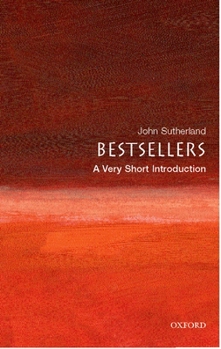Bestsellers: A Very Short Introduction
(Part of the Very Short Introductions (#170) Series and Oxford's Very Short Introductions series Series)
Select Format
Select Condition 
Book Overview
Lady Chatterley's Lover. The Blue Lagoon. Portnoy's Complaint. The Da Vinci Code. For the last century, the tastes and preferences of the common reader have been reflected in the American and British bestseller lists, and this Very Short Introduction takes an engaging look through the lists to reveal what we have been reading--and why. John Sutherland shows that bestseller lists monitor one of the strongest pulses in modern literature and are therefore...
Format:Paperback
Language:English
ISBN:0199214891
ISBN13:9780199214891
Release Date:December 2007
Publisher:Oxford University Press, USA
Length:144 Pages
Weight:0.30 lbs.
Dimensions:0.3" x 4.5" x 6.9"
Customer Reviews
2 ratings
Here Today, Gone Tomorrow
Published by Thriftbooks.com User , 15 years ago
John Sutherland's contribution to Oxford's VSI series is an informative condensation of major themes in the sociology of literature. It is not a comprehensive analysis of all bestselling genres (e.g., self-help books, popular history, etc.), nor is it exhaustive of all geographic areas (confining itself to the Anglo-American book markets). Nonetheless, Sutherland stays true to the VSI format (brevity and readability) and provides his readers with a pithy survey of major bestsellers and their social, literary, and cultural contexts. While it is true that there are other studies that deal with the bestseller phenomenon more extensively (of which Sutherland cites a handful in his bibliography), this VSI book has the advantage of inviting lay readers to reflect on the origins and development of bestseller marketing over the course of the twentieth century. Drawing from his wide knowledge of bestselling titles in the U.S. and Britain, Sutherland offers numerous examples of books that happened to capture their historical moment perfectly, only to fade away once that moment had passed. Sutherland is careful to point out the importance of genre (especially with crime fiction and westerns), political ideology (see his discussion of Tom Clancy and John Grisham), and media tie-ins (with 1976's *The Omen* as the landmark screenplay-novelization tie-in) in establishing a book's bestseller status in a given time and place. The examples are brief, but by the end of Sutherland's survey one has a good impression of the various strategies authors, publishers, and advertisers have used to secure books' lucrative, albeit fleeting, place on the bestseller lists. Again, there are other books out there that delve deeper into the bestseller phenomenon. Two titles Sutherland doesn't cite but that remain illuminating are Thomas Whiteside's *The Blockbuster Complex*, based on a series of articles he wrote for the *New Yorker* in the 1970s, and Andre Schiffrin's more recent *The Business of Books*. Still, Sutherland's VSI is a pleasant, accessible read, and one that brings lay readers into conversation with an enduring object of study in the sociology of literature.
Concise but informative
Published by Thriftbooks.com User , 16 years ago
This is a recent addition to Oxford's superb but inexpensive "Very Short Introduction" series, which tend to be handy to use, brief in duration, but packed with information (i.e., the perfect "plane book"). I have read other books on this subject, which largely focus on various past bestseller lists. The author here is attempting something more useful--to really explore the concept of what is a bestseller and what factors account for some books becoming bestsellers and others not. The author is British, so his focus is the U.S. and the UK, but he well explains how some common factors have impacted both countries. One of the more interesting findings is that due to the late agreement in the US to abide by British copyrights, many of the bestsellers in this country during the 19th century were cheap unauthorized reprints of British works. The author also discusses how the unique British marketing controls on books (essentially, no discounts; all sell at the same price) had an impact there. Separate chapters are devoted to American (with which the author is quite conversant) and British bestsellers. In the American chapter, the author suggests common factors which determined whether a book might be a bestseller, and establishes some analytical categories for this phenomenon. The text runs 113 pages, including some quite interesting and helpful illustrations, and also includes a short bibliograpy and index. The high production values associated with OUP are present here as well. While this book will never itself become a bestseller, it certainly provides an informative introduction to that topic.





